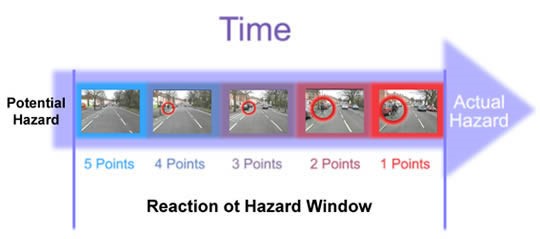The Hazard Perception Test makes up one of two elements of your Theory Test. Rather than have to answer questions, you will be presented with a series of videos, and your score will be based upon how long it takes you to react to the events in the videos by clicking the mouse. You will have to pass both the Hazard Perception and Q and A sections of the Theory Test in order to achieve an overall pass.
These hazard perception tips will help you prepare for, and pass, your Hazard Perception Test.
Know what makes a hazard
Each of the video clips you are shown will feature everyday road scenes with at least one developing hazard. A developing hazard is something that would cause you to have to take action, such as change your speed or direction in order to avoid a collision.
A vehicle joining from a side road, or a pedestrian crossing in front of you would be considered a developing hazard, whereas somebody performing these actions some distance up the road would not, as they should be out of the way before you reach them, and therefore there would be no need for you to take any action.
Practice makes perfect
Unlike the Q and A section of the theory test, you only get one chance to see each of the hazard perception video clips. Just like in real life, there are no do-overs if you fail to spot a developing hazard in time.
Although the Hazard Perception Test uses real life video clips, and is designed to mimic day-to-day driving as best it can, watching a video feels very different to driving a car, and you may find yourself asking how to pass hazard perception the first time you have a go at it. The best thing you can do is take several practice tests, so that you get a feel for them. Your driving school may be able to give you some links to videos on their own website, otherwise, you should be able to find plenty online with a quick search.
Click as soon as you see the hazard
Most of the clips will only show one hazard, although one of the 14 you will see will contain two hazards. For each, there is a maximum score of 5, which is awarded if you spot the hazard quickly. The longer it takes you to spot the potential hazard up ahead, the fewer points you will receive.

Image Source: https://www.theorytestadvice.co.uk/hazard-perception-test/about-the-hazard-perception-test.php
Only click when you see a developing hazard
While it may be tempting to click the mouse every time something changes, you are only being asked to make note of developing hazards. The computer will pick up on you clicking repeatedly, or in a regular pattern, and will give you a score of zero for any clips where it detects you performing this behaviour.
If you follow these tips, you should have a good understanding of what is expected of you in your Hazard Perception Test. Much of how it goes on the day will be down to your preparation, so the more preparation and practice you have done, the better your chances of success. Make sure you’re prepared with our guide to preparing for your theory test and our Top Ten Theory Test Apps.
Once you’ve passed your theory test, it’s time to get practicing for your practical. Find out more about learner driver insurance and why you need it.



